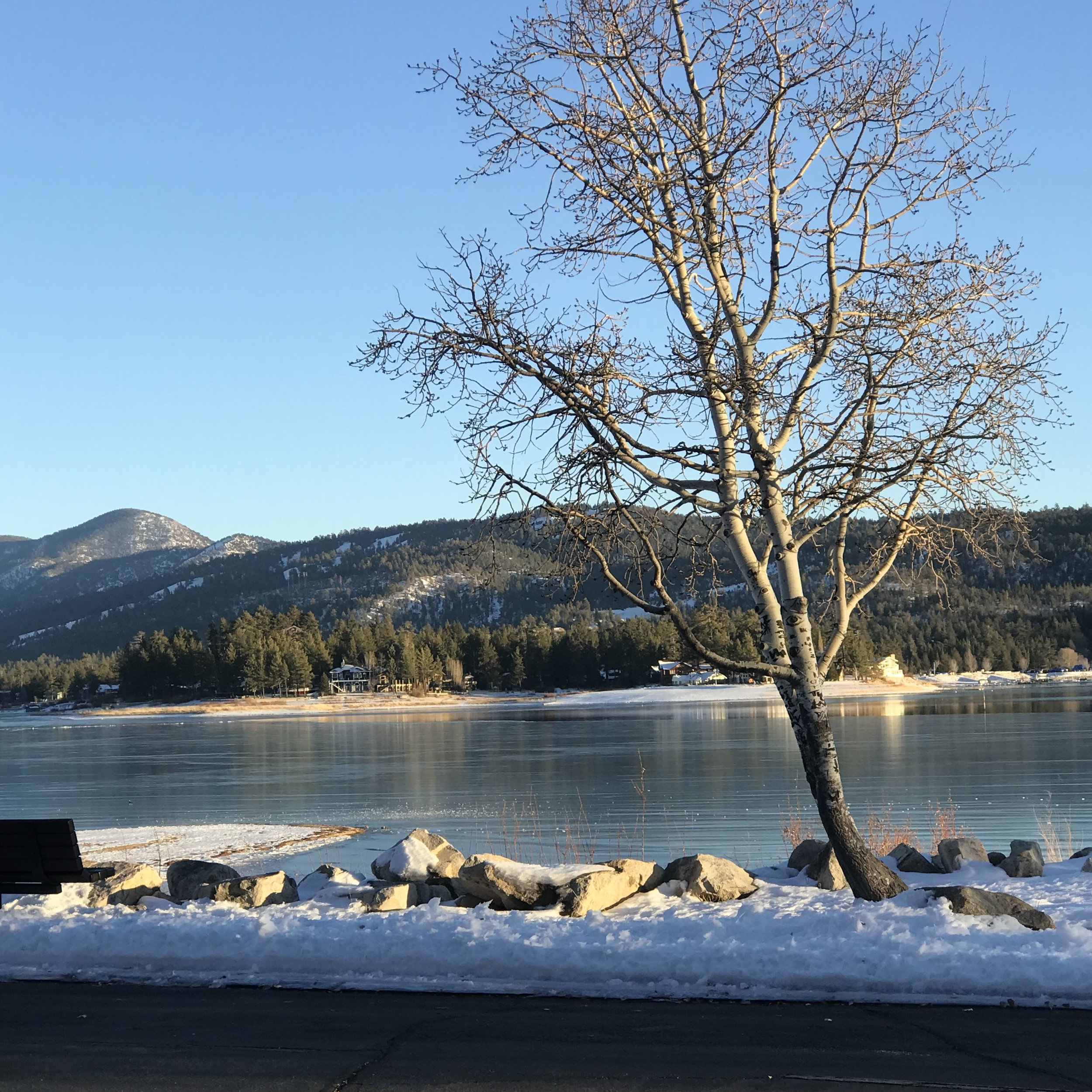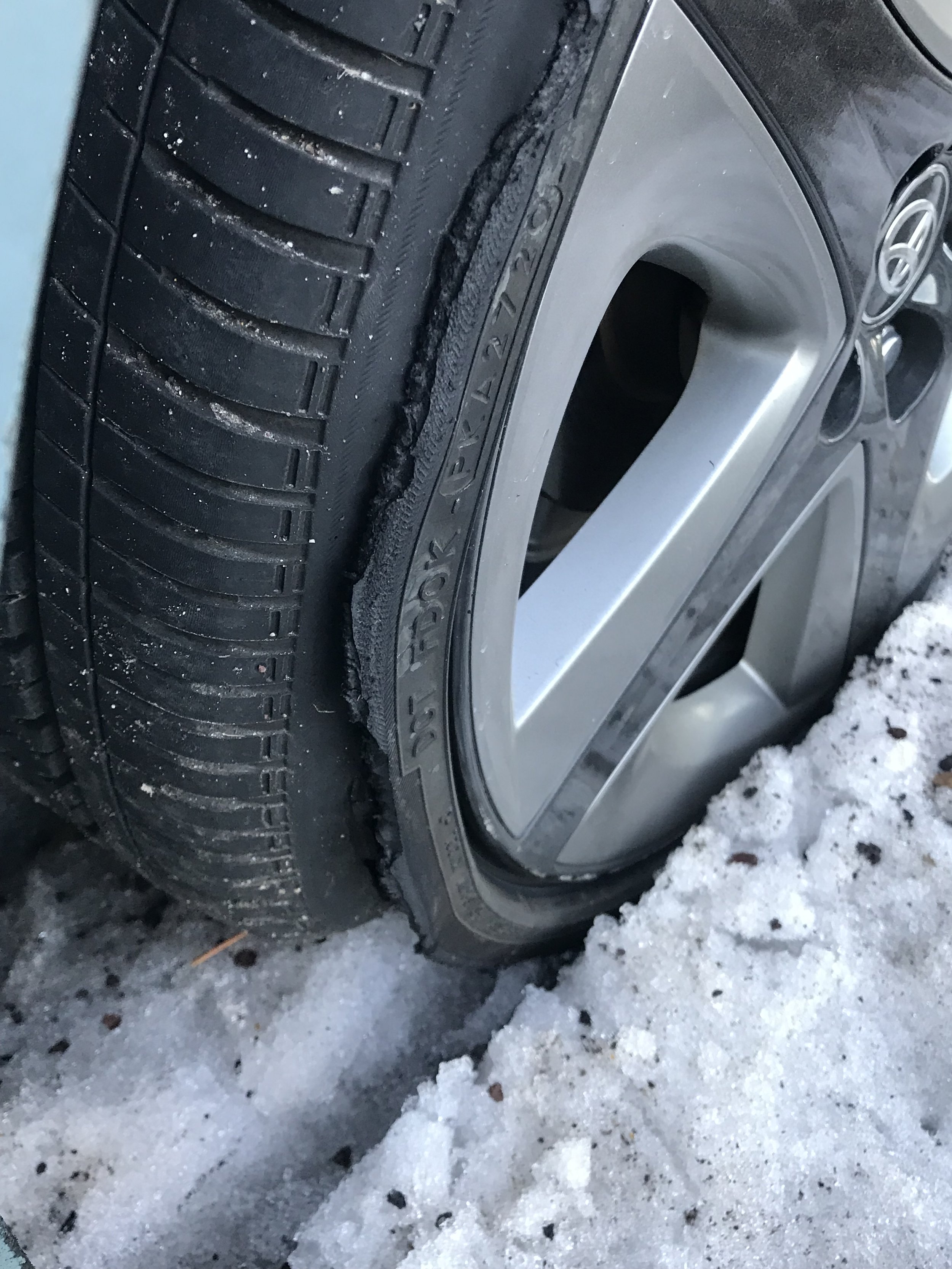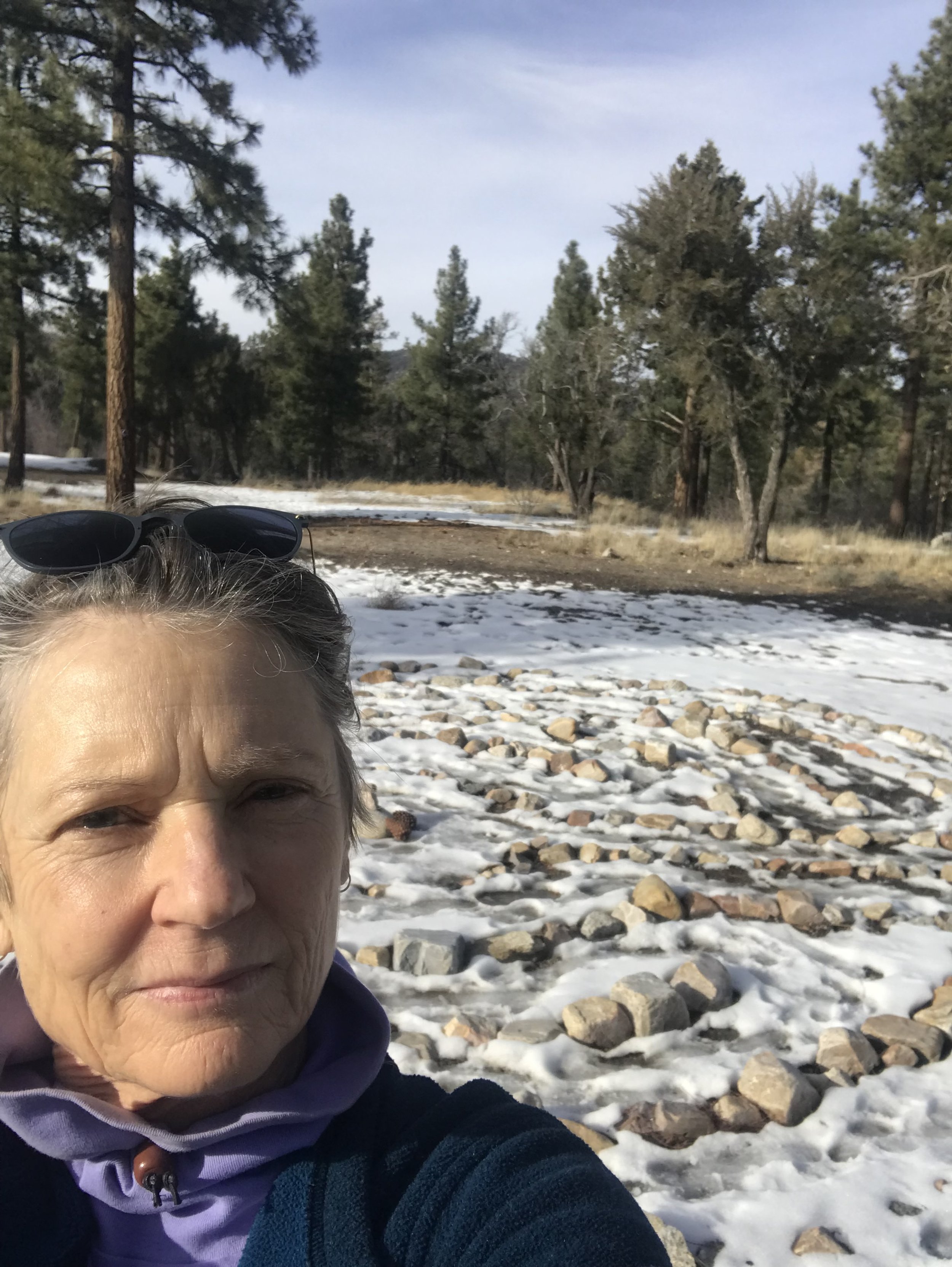The Meaning of SAFE
How a Narcissistic Father Shapes Us - Even as Adults.
Thump. Cur-thump. Thump. Thump. Thump. Thump. The steering wheel is an out-of-balance washing machine. The highway is narrow - two opposing lanes—speed limit is 50. My rearview mirror is full of an aggressive monster truck inhaling my bumper. The roadside drops into the lake.
There’s no place to pull over.
I take the ‘old lady driver’ posture - elbows pointing out and face close to the windshield, desperate for a turnout. As Monster Truck is about to bite, I flip the turn signal and pump the brake, praying a pothole is not hiding under the snow. Squishing into a small turnout, the monster truck roars past, followed by many cars.
“We’re Okay,” I say out loud once stopped, “It’s just a flat tire.” But something tells me I’m about to get in trouble. My child part hears my father’s voice;
Don’t you ever drive on a flat. Pull over immediately! You will destroy your wheel, which is a hell of a lot more expensive than plugging up a tire.
Dad was scary when I was five, twelve, and sixteen when I started to drive. I’m sixty-four now and still afraid of my dead father’s rage.
What’s happening in the side mirror makes my teeth grind.
schwoosssh
schwsosssh
schwsosssh
cars
whizz
past
Thank you, thank you for not hitting me.
I push the door open. The burning rubber smell makes me say, “uh oh, not good.” The rear tire looks fine, but the front tire, with acrid black smoke seeping out of rubber shreds, tells me a shovel and kitty litter will not get me where I want to go. So much for that remembered checklist:
Chains in case of a freak snowstorm
Shovel to dig me out of ditches
Kitty litter for traction if my wheels get stuck in a spin
Ice scraper to clear my vision
I get back behind the wheel of my motionless car.
A roadside assistance agent asks, “Are you in a safe place?”
There’s nothing but trees, snow-covered mountains, and an icy lake illuminated by late afternoon blueish sun. The bend in the road just behind makes me vulnerable to the unsuspecting motorists zooming fifty miles an hour inches from my side mirror. I lie to the voice coming through the car’s speaker; “Yes, I’m in a safe place.”
The part of me that lives in survival mode answered the roadside assistance dispatcher. This part thinks “safety” means:
Shaping myself to fit inside the needs of others.
Being pretty and sweet so I’ll be taken care of because I don’t have what it takes to make it on my own.
Staying small by not expressing needs.
The voice from the car’s speaker, interested in my safety, tells me she is looking up my car’s information. In a tight posture, I hang on to every word from the AAA dispatcher.
“Your car doesn’t have a spare tire.”
Stunned, I say, “What? How can that be?”
“They make them that way now.”
My head swirls. Who am I to think I can take care of myself?
Frightened, small, and defeated, I remember the guy who leased me the car mentioning the no spare-tire situation. He looked and smelled like James Bond. I wish he were here now.
AAA lady interjects herself into my movie fantasy about me being rescued by charismatic charm. “We’ll send a flatbed tow truck to haul you to the nearest dealership.”
“What? I’m kinda in the middle of nowhere.”
She confirms my isolation by saying, “The closest dealership from Big Bear is Redlands Toyota.”
I remember flying past signs to Redlands on the 210 freeway a long time ago, maybe an hour and a half. My waiting enlightenment at the retreat center is only fifteen minutes away, in the opposite direction,
“Let’s see,” she says, “it looks like the earliest we can have a truck to you is three hours, but it might be longer - things are super busy today.” AAA Lady keeps piling on the bad news.
“What? It will be dark by then, and I’m in the middle of nowhere.” I’m slightly aware I’m whining, which I don’t like, but I can’t help the habit.
She asks again, “Are you in a safe place?”
I notice the tree-shaped shadows reaching over the icy lake have grown longer as I have been bending my truth;
“Yes, I’m safe.” I say out loud as I ignore the tiny quiet voice on the inside saying, “Please help me.”
We disconnect. I sit, unmoving, staring at nothing, hoping the sun will stick right where it is to the sky and push down hard on the dark that’s coming. The sun doesn’t stick. It’s me that is stuck.
A few minutes ago, I was relieved when the navigation display on the dash reported I’d arrive at my destination in fifteen minutes. I’m at the end of the three-hour drive up the mountains outside of Los Angeles, where I will embark on a weeklong silent meditation intensive in Big Bear.
Now I’m left on the side of the road with my thoughts.
In the last year, with conscious effort and curiosity, I have met the various parts of myself taking over in different situations.
Schwoosssh. A car races by.
My wise adult self has found room to be in charge in situations such as these.
schwsosssh
Shaking off the constructed protective parts, which enabled survival in childhood, creates space for remembering who I was as a small child.
When I listen to the truth of my inner child part, the crooked shadows from my past straighten out just like the shadows of the trees around me.
schwsosssh
This meditation retreat over Christmas week aligns with my intention for my wise adult self to be present with my young inner child part, who longs to be seen and heard.
Visions of what is happening at the retreat drift in as darkness falls. I imagine people are getting to know each other as they gather for dinner.
I tear into the only sweetness available, a bag of cough drops. I suck on one lozenge after another as I wait and wait and arrange to be towed to a tire shop in town rather than Redlands Toyota. All my parts are grateful to be staying at the retreat center tonight instead of a Holiday Inn next to a car dealership.
schwsosssh
cars
whizz
past
After four mind-numbing hours, the tow truck, lit like a Christmas tree, cuts through the night.
“Thank God. We’re saved.” I say to my parts.
The driver rolls down his window. I greet him with a huge smile, but he doesn’t smile back.
Over the roar of his truck, I hear, “It’s not safe here. You need to move the car to the turnout a quarter mile up the road.”
He might not feel safe, but he doesn’t fear the outcome of driving on a flat that defies dead-dad.
My smile turns into a hard, judge-y look, kinda like my dad’s face when he’s about to knock someone across the room. “I can’t move this car. The tire is decimated. Driving will ruin the wheel.”
The driver blinks and I push harder. “Can’t you block the road with your big lit-up truck?”
To my delight, this expert in roadside safety gets to work doing his job on my terms. He says, “I need the key. Wait in the cab. It’s dangerous out here.”
I pulled myself into the cab. Damn, I’m powerful yet crooked-icky at the same time. I look back through the rear window at the truck driver dodging cars while hooking up chains and winches. My feeling of ick is familiar but not right.
Thankfully, we both survive getting my car to the tire shop in Big Bear. Then, realizing no one was coming to pick me up, the driver says he’ll give me a ride to the retreat center.
“Thank you. What’s your name, anyway?” I ask.
“It’s Tim.”
“Thank you, Tim! I’ll get my bags - be right back.” I make multiple slippery trips on black ice from my car to the cab.
“You gotta lot of shit,” Tim says when he looks up from his phone. I’ve given up trying to behave as if I have it all together, so I sit on the mountain of stuff I transferred from my car to the passenger seat. I’m dazed, exhausted, and disconnected. On the short drive to the retreat center, I learn Tim works twelve-hour shifts for weeks without a break.
“Why do you work so much?” I wonder out loud.
“I have three kids. I love my family, so I don’t mind the work, but I’d like to be with them more.”
Before I ask another question, Tim briefly holds his phone so I can see a picture, and then he takes a long look at the image. He works overtime to provide for his kids. As he gently touches the image of two young boys, cooked-icky washes through me again because he should be home - not out rescuing neurotic women with way too much baggage. I hope his kids get enough time with their dad.
A sign directs us onto the property of the retreat center. We find a spot vast enough for the truck to turn around.
I’ve arrived.
I stand next to the pile of my stuff outside a large rustic/elegant building with a big sign in black letters that spell - SITTING.
Tim looks down from the truck. From his perspective, this is the middle of nowhere. “Are you going to be alright?”
“Yes, Thank You. I’m right where I need to be.” This time it doesn’t feel like a lie.
The truck’s lights rumble down the hill. There’s no one around and I might be lost, but it’s a different form of ‘lost’ than when I am unaware of what part of myself has taken over.
I find my way by simply checking my phone for directions that the retreat coordinator had texted me.
You made it here!
Walk up the hill.
We are all in the dining hall.
When you see the word EATING, you are here.
Now that it’s dark, the temperature is well below freezing. The flashlight on my phone helps me navigate icy patches as I move without picking up my feet. My arms are ready to catch myself if I fall. My head is noisy:
How long is this hill? Did I miss dinner? Next year I’ll go to Hawaii. I’m so thirsty. It would be great to Jacuzzi. Where is my room? I wish I were home. How do I get my car back?
I am exasperated when I get to my room, so I miss the first SITTING session. Instead, I make my bed and climb in.
The sheets are scratchy. The bed is small. The heater roars next to the wall. I’m too hot. I’m too cold.
I’m too disappointed I missed dinner and orientation.
I should be settled in an immersive meditation experience, but my mind won’t shut down. It’s figuring out how I will get home.
I surrender the idea of trying to sleep when the wake-up bell rings outside my door at 5:30 am. It’s still dark, and yesterday’s melted snow has morphed into a skating rink for fairies on the frozen blacktop. I shuffle into the SITTING building and plop onto a cushion. The temple-like room has a platform in the front with a Buddha-like guy sitting cross-leg. He teaches the group:
Practice being like a net where you catch what is happening.
This imagery works. I gather the events of the past twenty-four hours in my net and make notes in the small journal I had stashed in the pocket of my hoodie. The teaching continues;
It’s important to investigate what gets us into trouble, not just what gets us out.
I look around to see if anyone else is taking notes. Nope. I must have missed something in orientation about being present and letting the teaching wash through without the grabbing and clinging that causes suffering.
Oh well, I say to myself. I suffered getting here, so I’m going to make sure something sticks by taking notes about the trouble of getting here.
He continues; One way to explore what gets us in trouble is seeing things as patterns. Then we can wonder how we got to where we are.
I scribble; Patterns. Wonder about them.
Moving my car to a safe place didn’t cross my mind because of my patterning - Do whatever it takes to keep dad from getting mad and convince Tim it is better to get hit by a car than disobey the shadows from the past that control me.
It also dawns on me I could have asked for more help during my experience of being stranded. I realize asking was beyond my comprehension. My wise adult self was highjacked by a pushy part, which was doing its job - protecting my inner little girl self who’s afraid of making dad angry.
What the Buddhist teacher says next lights me up. Who’s in the driver’s seat of your life?
Whoa. Weird. Is he reading my mind?
This teaching helped me realize the direct way to healing is to focus on the wounds accumulated from my dad. And the healing medicine is giving the little one inside - attention and understanding so the pushy-protective part can relax. Awakened now, my wise-adult part gets wiser and has her hands on the wheel.
On the drive home, back down the mountain, I strap my inner child in the passenger seat. We listen to music, sing, and talk about how great it will be to sleep in our cozy bed tonight. I didn’t get what I expected from my winter retreat, but I arrived home with a warm and grateful heart. The kind compassion transmitted to my protective and inner-child parts provides a sense of safety. This is a gift.
“By learning to be our true selves, we are serving our true nature.”
How do we become our true authentic selves?
Narcissistic abuse recovery evolves around this question. Identity is formed early in life. When as children, we are treated with anything less than nurturing parenting, our true self gets hidden. Constructs or false selves form naturally to protect us from the pain of abandonment, shame, and intrusion.
I hope this helps you understand that getting to know the parts of yourself is a clear path to living authentically.
###
If you are looking for a therapist in California or Arizona, please click HERE for a free 15-minute phone consultation. I’d be happy to hear about what is happening and see if we are a good match so I can help you recover from a narcissistic relationship.
Read more about how I can help here.
For more content related to healing from toxic antagonistic relationships and narcissistic abuse, subscribe below.


